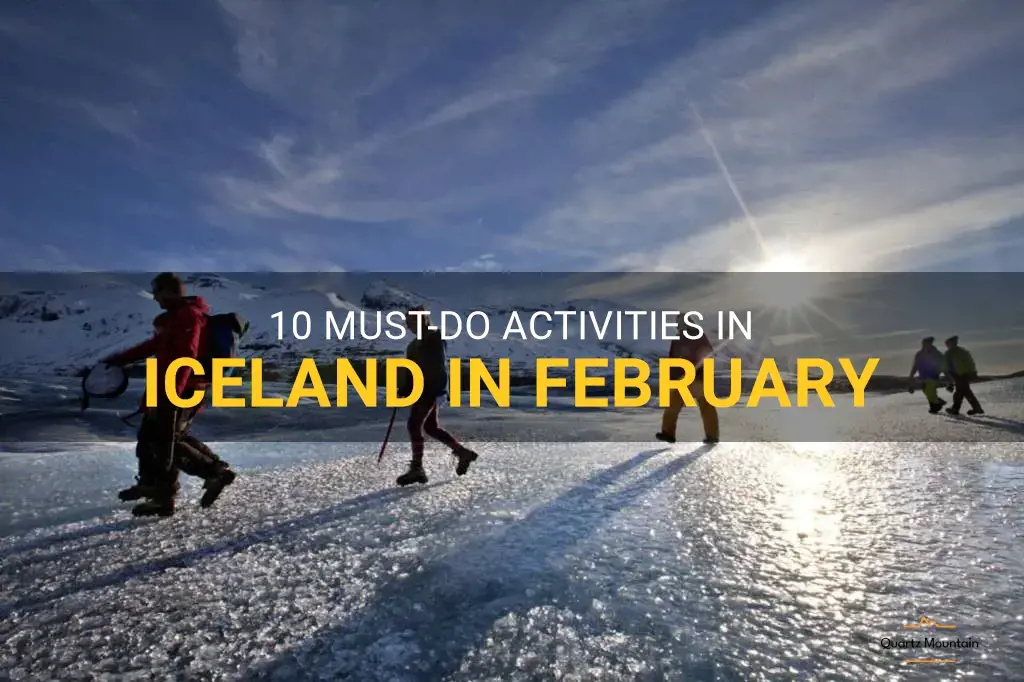
Welcome to the land of fire and ice! February in Iceland is a magical time when the country transforms into a winter wonderland. From stunning landscapes to exhilarating adventures, Iceland offers a plethora of activities that are a must-do during this time of the year. Whether you seek exhilarating outdoor adventures, breathtaking natural wonders, or a chance to witness the Northern Lights dancing across the sky, Iceland in February has something for everyone. So bundle up and get ready to experience the unique beauty and charm of this Nordic island paradise.
What You'll Learn
- Witness the mesmerizing Northern Lights
- Explore the stunning ice caves in Vatnajökull National Park
- Take a dip in the relaxing geothermal hot springs of the Blue Lagoon
- Go whale watching in Reykjavik
- Take a thrilling snowmobile ride on a glacier
- Visit the iconic Golden Circle, including Þingvellir National Park, Geysir, and Gullfoss waterfall
- Go on a thrilling winter hiking or ice climbing adventure
- Explore the magical ice sculptures at the Jökulsárlón Glacier Lagoon
- Experience a dog sledding tour through Iceland's winter landscapes
- Enjoy a traditional Icelandic meal and soak in the local culture

Witness the mesmerizing Northern Lights
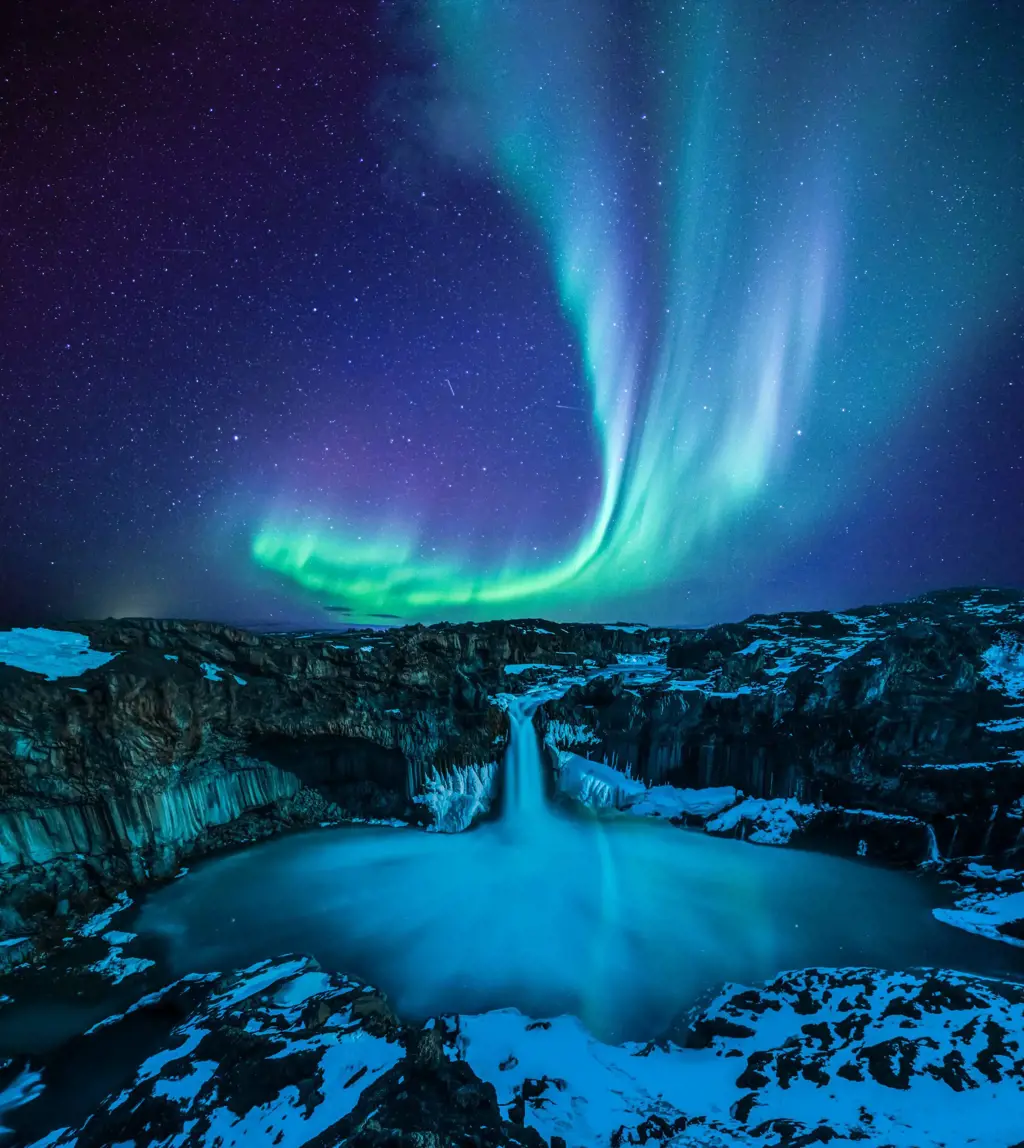
One of the most enchanting experiences you can have in Iceland in February is witnessing the mesmerizing Northern Lights. This natural phenomenon, also known as the Aurora Borealis, is a spectacular display of colorful lights dancing across the night sky.
In February, the conditions are perfect for viewing the Northern Lights in Iceland. The long winter nights and clear skies provide the ideal backdrop for this breathtaking spectacle. The lights are created when charged particles from the sun collide with the Earth's atmosphere, creating mesmerizing displays of green, purple, blue, and sometimes even red lights.
To witness the Northern Lights, it is best to head away from the bright city lights and find a secluded spot with a clear view of the sky. Popular locations for viewing in Iceland include the Golden Circle, Thingvellir National Park, and the Snaefellsnes Peninsula. These areas offer beautiful landscapes and little light pollution, making them ideal for capturing the perfect photo of the Northern Lights.
It is important to note that while February is a great time to see the Northern Lights in Iceland, they are a natural phenomenon and are never guaranteed. The lights are dependent on various factors, including solar activity and weather conditions. However, with patience and a bit of luck, you have a good chance of witnessing this awe-inspiring spectacle during your visit.
To increase your chances of seeing the Northern Lights, it is recommended to check the weather forecast and the Aurora forecast, which predicts the likelihood of visibility. Dress warmly in layers and bring a thermos of hot cocoa or coffee to keep warm during the wait. It is also helpful to bring a tripod and a camera with manual settings to capture the lights' beauty.
In addition to the Northern Lights, February is a great time to explore other attractions in Iceland. The country's unique landscapes, including ice caves, frozen waterfalls, and black sand beaches, are truly remarkable during the winter months. You can also indulge in winter activities like snowmobiling, ice climbing, and glacier hiking.
Overall, witnessing the mesmerizing Northern Lights in Iceland in February is an unforgettable experience. With the right conditions and a little bit of luck, you can witness the night sky come alive with vibrant colors, creating memories that will last a lifetime. So pack your warmest clothes, grab your camera, and get ready to be amazed by this natural wonder.
14 Romantic Things to Do in NYC for Valentine's Day
You may want to see also

Explore the stunning ice caves in Vatnajökull National Park
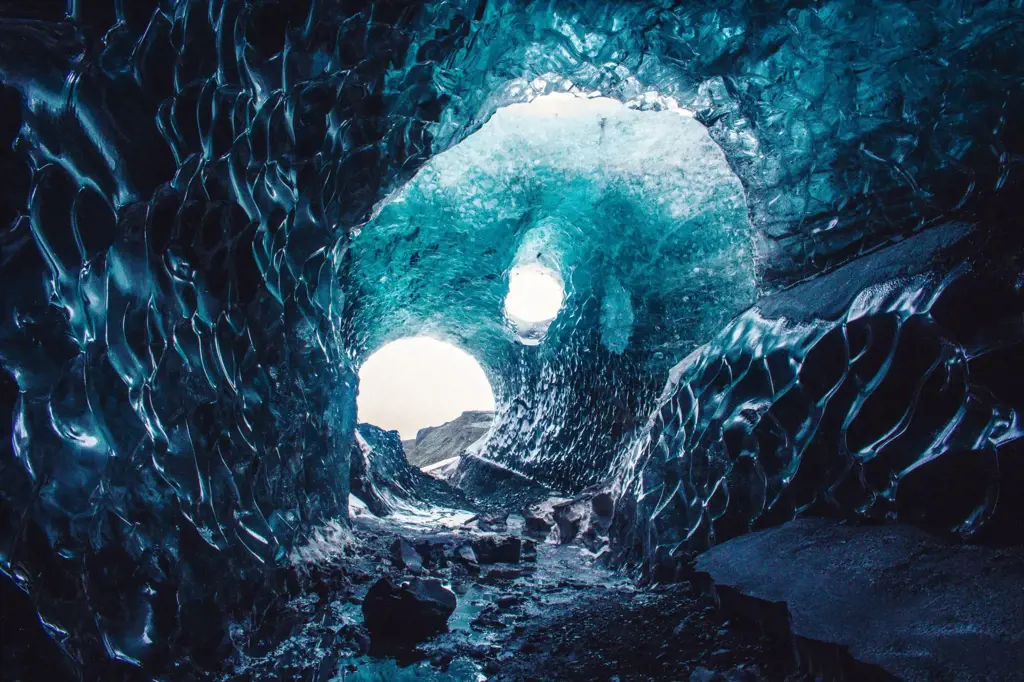
Iceland in February is a magical time to visit, especially if you are interested in exploring the stunning ice caves in Vatnajökull National Park. Located in southeastern Iceland, Vatnajökull National Park is home to the largest ice cap in Europe, covering an area of about 8,100 square kilometers.
During the winter months, the ice caves in Vatnajökull National Park take on a completely different appearance. The icy blue walls and unique formations create a mesmerizing sight that attracts adventure seekers from around the world. Exploring these ice caves requires a guided tour, as the caves can be dangerous to enter without proper equipment and knowledge.
February is an ideal time to visit Vatnajökull National Park and explore the ice caves. The weather conditions during this time of year provide the perfect conditions for the formation of these caves. The colder temperatures allow the ice to solidify and create intricate patterns throughout the caves.
To fully experience the ice caves, it is recommended to book a tour with a local guide who can lead you safely through the caves and provide interesting information about their formation and significance. These tours usually include transportation to and from the park, as well as all necessary equipment such as crampons and helmets.
Before embarking on your ice cave adventure, make sure to dress appropriately for the cold weather. Layering your clothing is essential, as it allows you to adjust your temperature as needed. Don't forget to wear warm and waterproof boots, as you will be walking on ice during the tour. It is also recommended to bring snacks and water, as the tour can last several hours.
Exploring the ice caves in Vatnajökull National Park is an unforgettable experience that allows you to witness the extraordinary beauty of nature. The shimmering blue ice and intricate formations will leave you in awe of the power and beauty of the natural world. So, if you're planning a trip to Iceland in February, don't miss the opportunity to explore these stunning ice caves.
11 Amazing Things to Do and See in Honokaa
You may want to see also

Take a dip in the relaxing geothermal hot springs of the Blue Lagoon
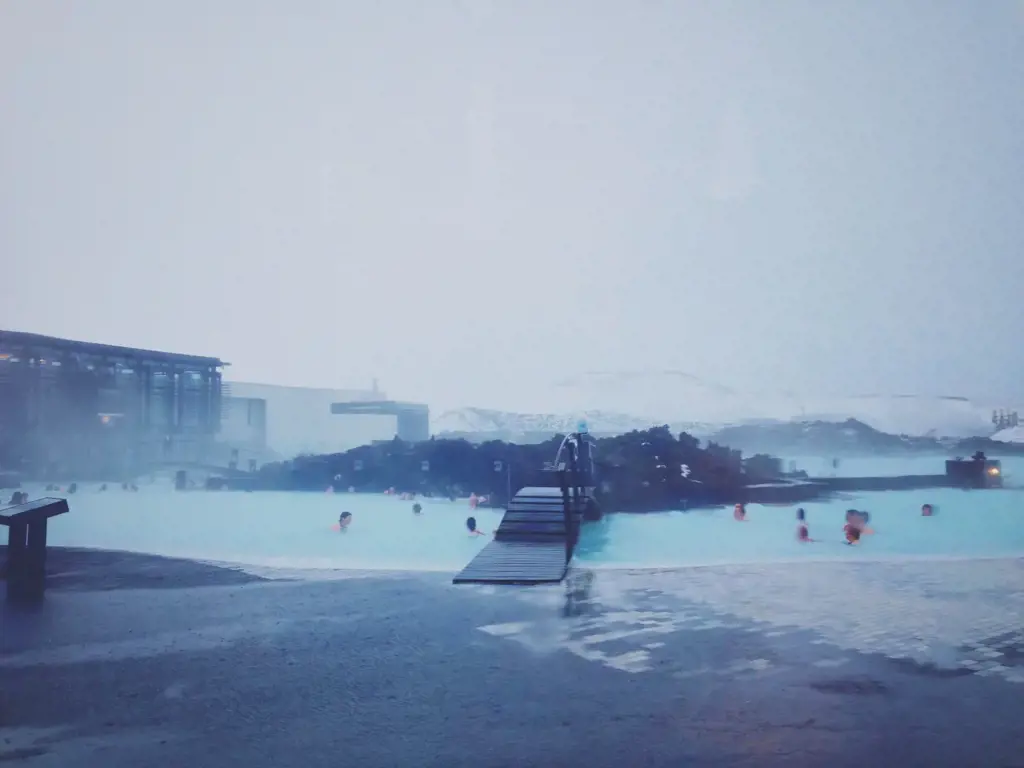
When it comes to visiting Iceland in February, one of the best activities to indulge in is taking a dip in the famous Blue Lagoon. This geothermal spa is a popular tourist attraction and offers a unique experience that cannot be missed.
Situated in a lava field on the Reykjanes Peninsula, the Blue Lagoon is surrounded by stunning landscapes that are covered in snow during the winter months. This creates a picturesque setting that adds to the overall charm of the spa.
The warm, milky-blue waters of the Blue Lagoon are known for their healing properties and are rich in minerals such as silica and sulfur. These minerals are believed to have various health benefits, including soothing the skin and rejuvenating the body.
Taking a dip in the Blue Lagoon during February can be a wonderful experience. While the temperatures outside may be cold, the waters of the lagoon are heated and remain comfortably warm all year round. This creates a stark contrast between the freezing temperatures outside and the warm, relaxing waters inside the lagoon.
The Blue Lagoon offers a range of facilities to enhance your experience. You can rent towels, bathrobes, and slippers, making it easy to relax and enjoy your time at the spa. The lagoon also has a bar where you can indulge in refreshing beverages such as smoothies or even a glass of champagne.
The spa also offers various treatments and massages that can further enhance your experience. You can choose from a range of options, including in-water massages or even a silica mud mask that can leave your skin feeling refreshed and rejuvenated.
Visiting the Blue Lagoon in February also has the added advantage of fewer crowds. While the spa can get quite busy during the peak tourist season, visiting in February allows you to enjoy a more peaceful and serene experience.
In conclusion, visiting the Blue Lagoon in February is a must-do activity when in Iceland. The warm, mineral-rich waters provide a relaxing and rejuvenating experience amidst the beautiful winter landscapes. So, don't miss out on this unique opportunity to take a dip in one of the world's most famous geothermal spas.
13 Ideas for Solo Stoners: Things to Do While High Alone
You may want to see also

Go whale watching in Reykjavik
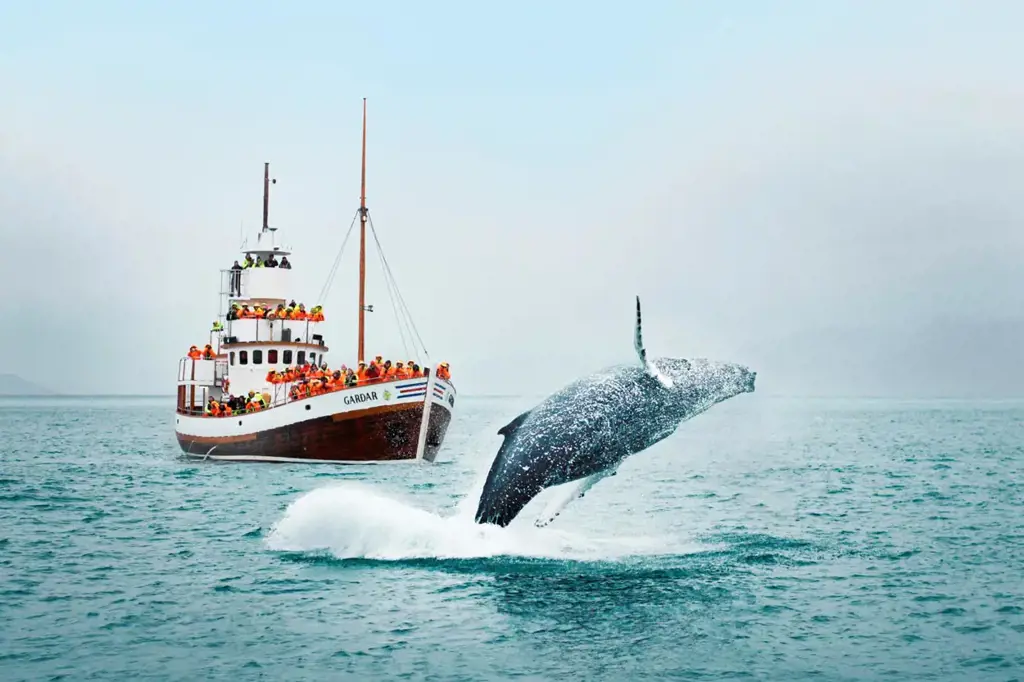
Iceland in February is a magical time to visit this northern island nation. Despite being the winter season, the landscapes transform into a picturesque wonderland covered in snow and ice. The cold temperatures offer a unique opportunity to partake in popular winter activities and witness breathtaking natural phenomena like the Northern Lights. One highly recommended experience that visitors should not miss is whale watching in Reykjavik.
Reykjavik, Iceland's capital city, is located on the southwest coast of the island. It serves as an excellent base for exploring the country's stunning natural beauty. While many visitors come to Reykjavik to embark on the famous Golden Circle tour or soak in the geothermal waters of the Blue Lagoon, whale watching is an equally exciting and worthwhile experience.
In February, the coastal waters around Reykjavik become home to a variety of whale species, including humpback whales, minke whales, and orcas. These majestic creatures migrate to the rich feeding grounds of Iceland's waters during this time of the year, providing an incredible opportunity for wildlife enthusiasts to observe them up close.
Several reputable whale watching companies operate from Reykjavik's Old Harbor, offering daily tours that depart in search of these magnificent creatures. The tours are usually conducted on purpose-built boats equipped with expert guides who share their knowledge about Iceland's marine life and provide fascinating insights during the journey.
One of the advantages of whale watching in Reykjavik in February is the relative lack of crowds compared to the peak summer months. This allows for a more intimate and peaceful experience, with fewer boats competing for the best views of the whales. The stillness of the winter months also adds to the serenity of the experience, as the calm waters create a tranquil atmosphere that enhances the feeling of being in nature's presence.
Though the weather in February can be cold and unpredictable, the tour operators provide warm clothing to ensure that visitors stay comfortable throughout the excursion. The boats are equipped with indoor seating areas, allowing passengers to retreat inside if they need a break from the elements.
While whale sightings cannot be guaranteed, the chances are high during the winter months, particularly in the waters surrounding Reykjavik. If luck is on your side, you may witness the breathtaking sight of humpback whales breaching, or the powerful flip of an orca's tail as it dives beneath the surface. These close encounters with these magnificent creatures are sure to create memories that will last a lifetime.
In addition to the whales, it is also possible to spot other marine life such as dolphins, seals, and a variety of seabirds during the tour. The guides on board are experienced and skilled in locating and identifying these animals, ensuring an informative and enjoyable experience for everyone on board.
In conclusion, whale watching in Reykjavik in February is a must-do activity for any visitor to Iceland during this time of the year. The awe-inspiring sight of these majestic creatures in their natural habitat, combined with the serene winter landscapes, will leave you with a profound appreciation for the beauty and wonder of Iceland's marine life. So bundle up, grab a warm drink, and embark on an unforgettable adventure in the icy waters of Reykjavik.
11 Best Things to Do in Monrovia, Liberia
You may want to see also

Take a thrilling snowmobile ride on a glacier
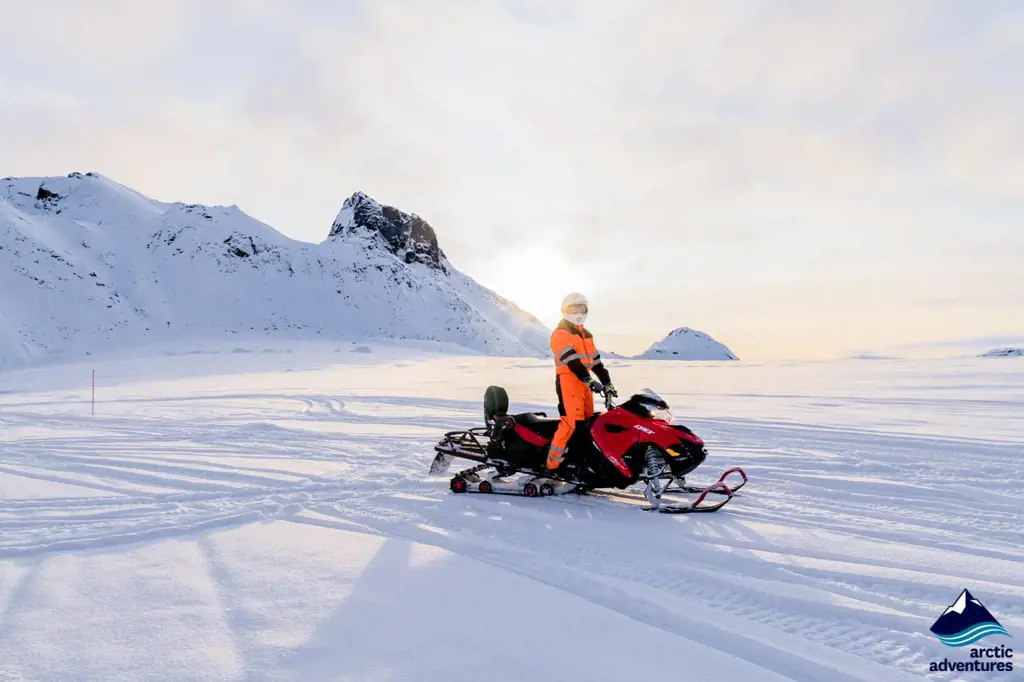
If you're planning to visit Iceland in February, one thrilling activity you shouldn't miss is taking a snowmobile ride on a glacier. Iceland is known for its stunning glaciers, and this is a unique and exciting way to experience the beauty of these icy landscapes.
Glaciers cover about 11% of Iceland, making it one of the best places in the world to explore these natural wonders. In February, the weather conditions are perfect for snowmobile rides, with the temperature hovering around freezing and plenty of snow covering the glaciers.
One popular location for snowmobiling is the Langjökull glacier, which is the second-largest glacier in Iceland. Located in the highlands of Iceland, Langjökull offers breathtaking views and an exhilarating snowmobile experience. You can choose from various guided tours that take you across the glacier, allowing you to witness the vastness and beauty of the frozen landscape.
Before embarking on your snowmobile adventure, you'll receive all the necessary equipment and safety instructions from experienced guides. They will ensure that you are properly equipped and comfortable before setting off on your snowmobile. Most operators provide warm overalls, helmets, and gloves to protect you from the cold, so you can fully enjoy the ride without worrying about the weather.
As you navigate the icy terrain on your snowmobile, you'll feel the adrenaline rush as you race across the white expanse. The feeling of freedom and excitement cannot be matched, as you zip through the snow, surrounded by the majestic scenery of the glacier.
During the tour, your guide will also share interesting facts about the glaciers and the surrounding area, giving you insights into the unique environment that you're exploring. You might learn about the formation of glaciers, their importance in shaping the landscape, and how they are affected by climate change.
Depending on the duration of your snowmobile tour, you might also have the opportunity to stop and admire the incredible ice formations, deep crevasses, and stunning ice caves that are scattered across the glacier. These natural formations are truly a sight to behold and provide ample opportunities for capturing stunning photographs.
When planning your snowmobile adventure, it's important to book in advance, especially during the peak tourist season in February. The popularity of snowmobiling means that spots can fill up quickly, so it's advisable to secure your place beforehand.
In conclusion, if you're visiting Iceland in February, don't miss the chance to take a thrilling snowmobile ride on a glacier. It's an experience that will leave you with lifelong memories and a deeper appreciation for the extraordinary beauty of Iceland's glaciers. Whether you're an adrenaline junkie or simply a nature lover, this exciting adventure is sure to be the highlight of your trip.
13 Fun Things to Do in Fisherman's Wharf
You may want to see also

Visit the iconic Golden Circle, including Þingvellir National Park, Geysir, and Gullfoss waterfall
Iceland is a beautiful country to visit any time of the year, but February offers a unique and truly magical experience. Despite the cold weather, there are plenty of attractions and activities to enjoy during this month. One of the must-visit destinations in February is the iconic Golden Circle, which includes Þingvellir National Park, Geysir, and Gullfoss waterfall.
Þingvellir National Park is a UNESCO World Heritage Site and one of the most important historical and geological sites in Iceland. It is located on the rift valley between the Eurasian and North American tectonic plates. In February, the park is covered in a white blanket of snow, creating a stunning landscape. Visitors can explore the park's walking trails, admire the frozen lakes, and even go snorkeling or diving in the Silfra fissure, which is filled with crystal clear glacial water.
Geysir is another popular stop on the Golden Circle route. This geothermal area is home to the famous Geysir hot spring, which erupts every few minutes, shooting hot water and steam into the air. In February, the sight of Geysir surrounded by snow is truly enchanting. Visitors can also explore the other smaller geysers and bubbling hot springs in the area, marveling at the power and beauty of Iceland's geothermal activity.
Gullfoss waterfall is the final stop on the Golden Circle route and one of Iceland's most famous waterfalls. In February, the waterfall cascades down in two tiers and is partially frozen, creating a breathtaking scene. Walking along the snow-covered paths, visitors can get up close to the impressive waterfall and feel the mist on their faces. It's an incredible sight that should not be missed during a winter visit to Iceland.
Aside from the Golden Circle, February is a great time to experience other winter activities in Iceland. You can go on a thrilling snowmobile tour on a glacier, explore ice caves, or even go skiing or snowboarding. Some tour operators also offer the chance to experience the mesmerizing Northern Lights, which are more likely to be visible during the winter months.
It's important to note that February weather in Iceland can be unpredictable, with snowstorms and strong winds. It's recommended to pack warm and waterproof clothing, as well as sturdy hiking boots. Also, be prepared for shorter daylight hours, with only a few hours of sunlight each day.
Visiting Iceland in February offers a unique and unforgettable experience. Exploring the Golden Circle, including Þingvellir National Park, Geysir, and Gullfoss waterfall is a must-do activity during this time. The stunning winter landscape, combined with the chance to witness natural wonders and indulge in thrilling winter activities, make February an ideal month to visit Iceland.
13 Exciting Things to Do in Lake Placid, Florida
You may want to see also

Go on a thrilling winter hiking or ice climbing adventure
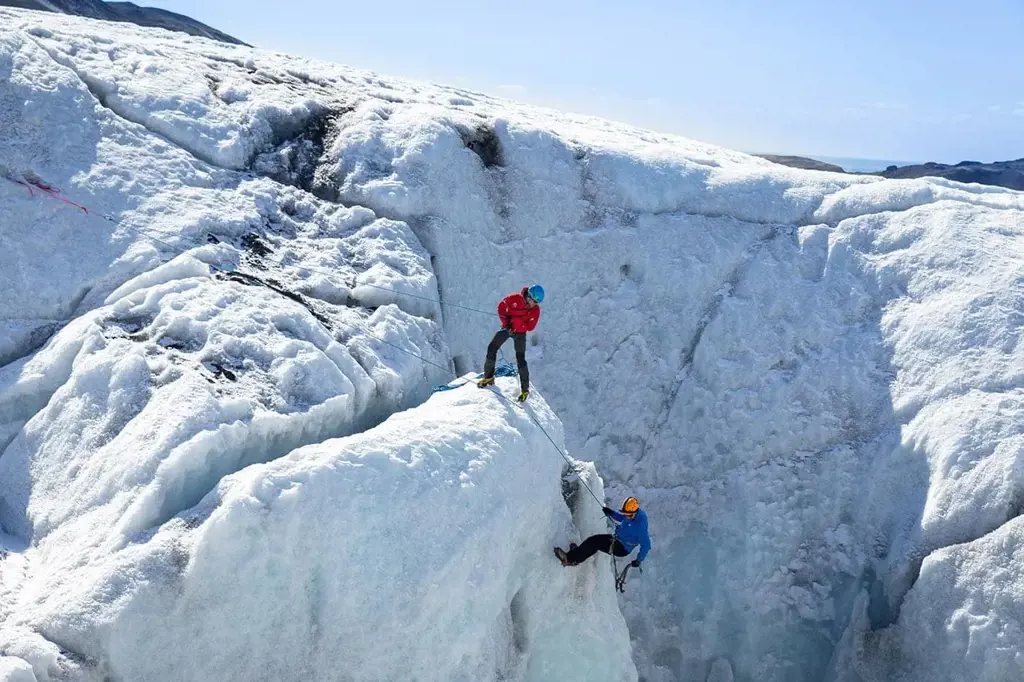
Iceland in February is a magical time of year to visit this stunning Nordic country. While the weather might be cold and snowy, there are plenty of thrilling adventures to be had, especially if you're a fan of winter hiking or ice climbing.
One of the best things about visiting Iceland in February is the chance to take part in a winter hiking expedition. The country is home to numerous glaciers and snow-covered mountains, making it the perfect destination for outdoor enthusiasts looking for a challenging and breathtaking experience. Whether you're a seasoned hiker or a beginner, there are plenty of options to choose from, ranging from easy walks to more strenuous climbs.
One popular winter hiking trail is the Fimmvörðuháls Pass, which takes you through the stunning Þórsmörk Valley. This hike offers incredible views of glaciers, waterfalls, and volcanic landscapes. The trail is well-marked, but it's important to be prepared for changing weather conditions and icy terrain. It's recommended to go on this hike with a knowledgeable guide who can ensure your safety and provide interesting information about the surroundings.
For those looking for an even more adrenaline-pumping adventure, Iceland in February also offers fantastic ice climbing opportunities. The country is known for its countless ice walls and frozen waterfalls, making it a playground for ice climbers of all levels. Whether you're a beginner or an experienced climber, there are plenty of options available for you.
One of the most popular ice climbing spots in Iceland is Sólheimajökull. This stunning glacier is located in the southern part of the country, and it offers a variety of routes for climbers of all abilities. You can choose to climb vertical ice walls, frozen waterfalls, or even explore ice caves. Again, it is highly recommended to go on an ice climbing excursion with a certified guide who can provide you with the necessary equipment and ensure your safety at all times.
When planning your trip to Iceland in February, it's important to pack the right gear. Layers of warm clothing, waterproof and windproof outerwear, sturdy hiking boots, and crampons for ice climbing are essential. It's also a good idea to bring extra gloves, hats, and scarves, as well as a camera to capture the incredible beauty of the Icelandic winter landscape.
In conclusion, Iceland in February is a paradise for winter hiking and ice climbing enthusiasts. The country's stunning glaciers, snow-covered mountains, and frozen waterfalls offer endless opportunities for adventure. Whether you choose to go on a challenging hike or tackle an icy wall, you're sure to have an unforgettable experience in this winter wonderland. So, pack your gear, grab a guide, and get ready for an adventure of a lifetime in Iceland!
13 Fun Things To Do In Janesville WI
You may want to see also

Explore the magical ice sculptures at the Jökulsárlón Glacier Lagoon
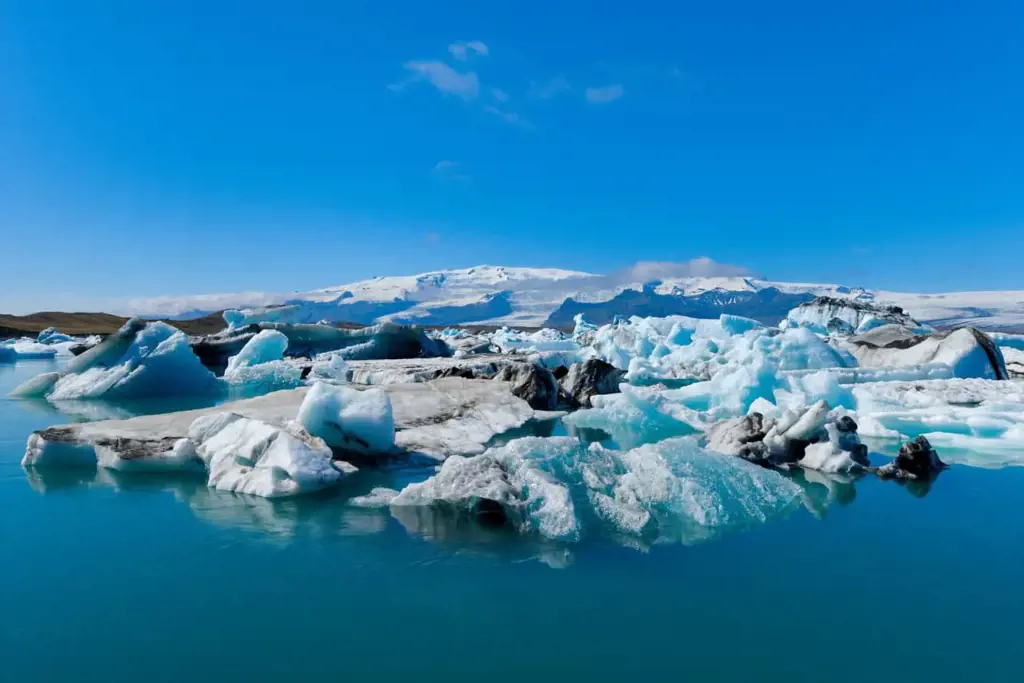
In February, Iceland transforms into a winter wonderland, making it the perfect time to explore the country's stunning ice sculptures. One of the most iconic locations to witness these majestic formations is the Jökulsárlón Glacier Lagoon.
Located in the southeastern part of the country, Jökulsárlón is a glacial lake filled with floating icebergs that have broken off from the surrounding Vatnajökull glacier. These icebergs vary in size, shape, and color, creating a visually stunning display that is truly a feast for the eyes.
The lagoon is easily accessible by car and is a popular stop for travelers exploring the famous Ring Road. During February, the temperatures are at their coldest, allowing the icebergs to become more solid and stable, making it a great time to visit if you're looking to experience the true beauty of ice sculptures.
While visiting the Jökulsárlón Glacier Lagoon in February, you can take a boat tour that will navigate through the icebergs, providing an up-close and personal look at these incredible formations. The tour guides are knowledgeable about the area, and they will share information about the glacier's history, geology, and the unique ecosystem that thrives in and around the lagoon.
If you prefer to stay on land, you can walk along the black sandy shores of the lagoon and marvel at the icebergs from a distance. The contrast between the glistening ice and the dark sand creates a striking visual contrast that is truly mesmerizing.
In addition to the ice sculptures, Jökulsárlón is also home to a variety of wildlife, including seals that can often be seen lounging on the floating icebergs. February is a great time to spot these graceful creatures as they are more prevalent during the winter months.
Visiting Jökulsárlón in February not only allows you to witness the magical ice sculptures but also provides the opportunity to witness the Northern Lights, one of nature's most incredible light shows. The clear skies and the remote location of the lagoon make it an ideal spot for viewing this celestial phenomenon.
To fully enjoy your experience, it's important to dress warmly in layers, as temperatures in Iceland can drop significantly in February. Be sure to wear a good pair of waterproof boots and bring a hat, gloves, and a warm jacket. It's also advisable to bring a camera to capture the beauty of the ice sculptures and the possibility of catching a glimpse of the Northern Lights.
In conclusion, if you're planning a trip to Iceland in February, make sure to include Jökulsárlón Glacier Lagoon on your itinerary. The chance to witness the magical ice sculptures, spot seals, and potentially see the Northern Lights make it an unforgettable experience. Bundle up, bring your sense of wonder, and prepare to be amazed by the winter beauty of this incredible destination.
13 Spooky Things to Do in Boston on Halloween
You may want to see also

Experience a dog sledding tour through Iceland's winter landscapes
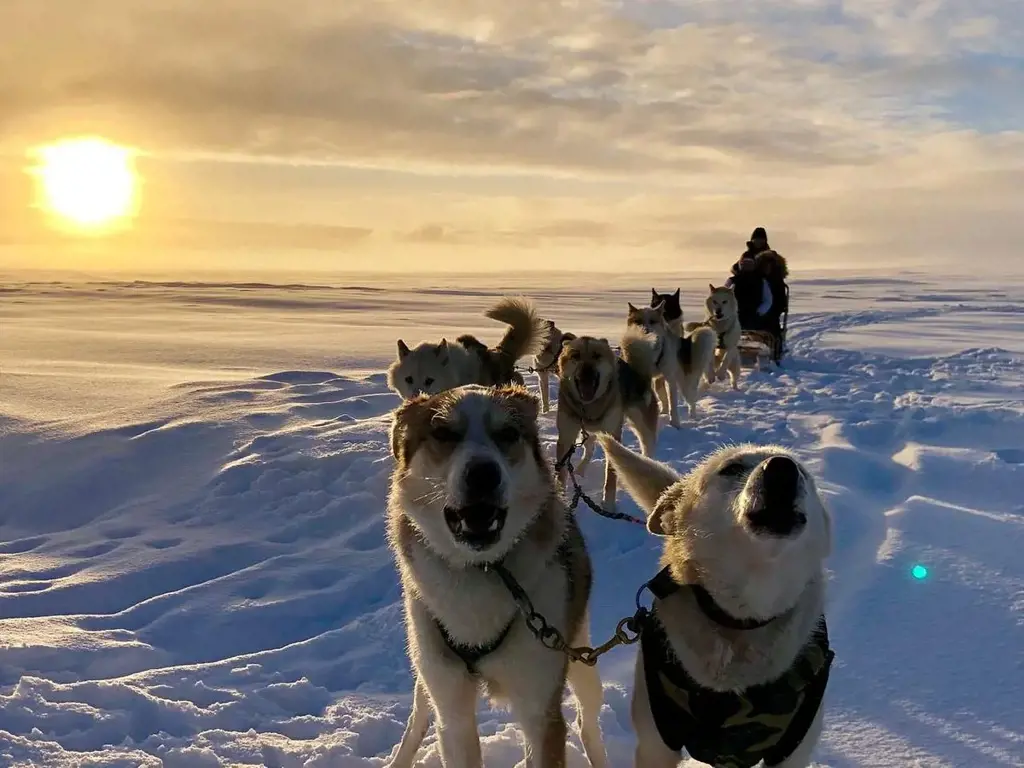
Iceland is a magical destination to visit in February. While the weather may be cold, the country's unique winter landscapes offer incredible experiences. One such experience is going on a dog sledding tour through the snow-covered terrain.
Dog sledding is a popular winter activity in Iceland, and February provides an ideal time to embark on this adventure. The country's magnificent scenery becomes even more breathtaking during this time, with frozen waterfalls, snowy valleys, and ice-covered mountains creating a winter wonderland.
The dog sledding tours typically take place in remote areas, away from the hustle and bustle of cities. This allows visitors to fully immerse themselves in the tranquility and beauty of Iceland's winter landscapes. The tours are guided by experienced mushers who have an in-depth knowledge of the area and the dogs.
When participating in a dog sledding tour, visitors have the opportunity to bond with the strong and friendly sled dogs. Icelandic sled dogs are known for their strength and endurance, making them the perfect companions for this activity. The dogs are well-trained and love to run through the snow, pulling the sled along effortlessly.
The tours usually last for a few hours, giving participants plenty of time to enjoy the surroundings and soak in the beauty of the Icelandic winter. Visitors can expect to glide through snowy trails, pass by frozen lakes, and witness the untouched nature of the country. The silence of the winter landscape, broken only by the sound of the sled gliding over the snow, is a truly magical experience.
One of the highlights of a dog sledding tour in Iceland is the possibility of seeing the Northern Lights. February is one of the best months to witness this natural phenomenon, and being out in the wilderness on a clear night increases the chances of spotting the dancing lights in the sky. The combination of dog sledding and the Northern Lights creates a once-in-a-lifetime experience that will be cherished forever.
It's important to note that dog sledding tours in Iceland are conducted with the utmost respect for the animals and the environment. The dogs are well-cared for and receive proper rest and nutrition. The tours follow strict guidelines to ensure the safety and well-being of both the dogs and the participants.
In conclusion, experiencing a dog sledding tour through Iceland's winter landscapes in February is a truly remarkable adventure. The chance to explore the snowy terrain, bond with friendly sled dogs, and possibly witness the Northern Lights makes for an unforgettable experience. So bundle up, embrace the chilly weather, and embark on this thrilling journey through the enchanting winter wonderland of Iceland.
12 Exciting Activities Near Oak N Spruce Resort to Fill Your Vacation Days
You may want to see also

Enjoy a traditional Icelandic meal and soak in the local culture

February is a great time to visit Iceland and experience its unique culture and cuisine. One of the best ways to immerse yourself in Iceland's local culture is by enjoying a traditional Icelandic meal. Icelandic cuisine is known for its emphasis on fresh, local ingredients and simple preparation. Here are some must-try dishes and experiences to enjoy during your visit to Iceland in February.
One of the most iconic Icelandic dishes is the infamous fermented shark, known as hákarl. This traditional dish is made from Greenland shark that has been buried underground for several weeks to ferment. The result is a strong, pungent smell and a unique taste that is definitely an acquired one. While hákarl may not be to everyone's liking, it is definitely a memorable and authentic Icelandic experience.
For those looking for something slightly less adventurous, you can try another Icelandic staple dish called "kjötsupa." Kjötsupa is a traditional Icelandic lamb soup that is hearty and full of flavor. Made with tender pieces of lamb, root vegetables, and herbs, this soup is perfect for warming up on a chilly February day. It is often served with freshly baked rye bread, which is a staple in Icelandic cuisine.
During your visit to Iceland in February, make sure to also try some fresh Icelandic seafood. With its abundant coastline, Iceland is known for its delicious seafood. Whether it's Icelandic salmon, cod, or langoustine, you can't go wrong with any seafood dish in Iceland. Be sure to also try "harðfiskur," which is dried fish that is often eaten as a snack or added to soup.
To truly soak in the local culture while enjoying your meal, consider visiting a traditional Icelandic restaurant or attending a local food festival. These events often feature live music, traditional dances, and other cultural performances. This will not only give you a taste of Icelandic cuisine but also expose you to the rich cultural heritage of the country.
In addition to indulging in traditional Icelandic meals, there are many other activities to enjoy in Iceland in February. Go on a guided tour to see the breathtaking ice caves, take a dip in the warm waters of the Blue Lagoon, or go on a thrilling snowmobile tour on a glacier. February is also an excellent month for witnessing the mesmerizing Northern Lights, as the long nights and clear skies provide the perfect conditions for this natural phenomenon.
In conclusion, visiting Iceland in February is a fantastic opportunity to experience the country's unique culture and cuisine. Whether you're indulging in traditional Icelandic dishes like fermented shark and lamb soup, or exploring the stunning natural landscapes, there is something for everyone to enjoy. So pack your warmest clothes and get ready for an unforgettable adventure in Iceland!
13 Fun and Interesting Things to Do in Tigard, Oregon
You may want to see also








3 Comments
Caleb Stanton
Elani Piper
AuthorBrendon Guzman